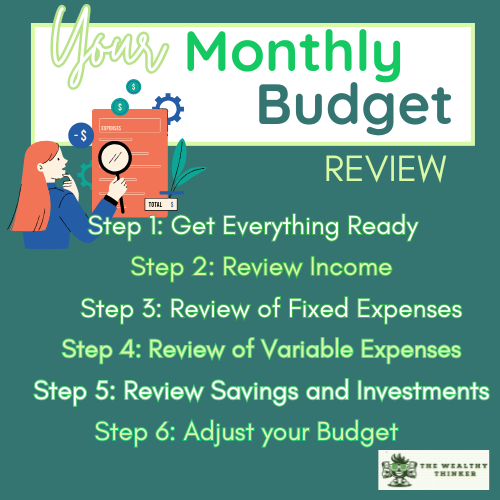Reviewing your monthly budget can be a powerful tool to gain control over your finances and set yourself up for financial success.
It’s more than just a routine; it’s an opportunity to:
- reflect on your spending habits
- align your financial goals
- make adjustments to stay on track
When approached with consistency and purpose, a monthly budget review can help you:
- identify patterns
- catch unnecessary expenses
- create a roadmap toward your financial goals
This six-step guide will walk you through each part of the process, from gathering your documents to making adjustments for the month ahead.
Whether you’re just starting out or looking to refine your approach, following these steps can make budgeting easier and more effective.
Let’s dive into these practical steps to help you feel more organized, prepared, and empowered every month!

Reviewing Your Monthly Budget: A Helpful 6 Step Guide
Step 1: Prep for the Review
Before even looking at your monthly budget, the first step to take is to prepare for your monthly budget review. This step is often overlooked, but it’s so important!
By preparing to review your budget, you’re gathering all the financial documents you need and setting aside time to focus. It will make this entire process so much easier.
In this step, you need to gather everything you’d need for your review. Documents to gather are:
- Bank statements
- Pay stubs
- Utility bills
- Credit card statements
These documents will be used in other steps, so it’s good to have them before you do your review. Covering this step also puts you into the right state of mind.
You’ll also want to set aside a specific time when you start this step.
It’s best to review your monthly budget on the same day of the week around the same time of the month. Usually, doing this towards the last day of the month is the best. You can even choose to review your budget on the last weekend of every month.
This consistency will allow you to go through all the steps more quickly and (hopefully) not dread reviewing your budget.
Step 2: Review Income
Once you’ve gathered all the financial documents that you need, the next step is to review your income. Even if you have a full-time job with a stable income, this is still a step you don’t want to skip.
You’ll want to confirm your income for that previous month and check:
- pay stubs
- deposit records
- any other sources of income
Income can be any money that you are bringing in from a job or somewhere else. If you sold something on Facebook Marketplace, mark that as income earned that month.
Or if you received cash as a gift, mark that as income. Using online tools like Credit Karma or a spreadsheet can help make this step easier.
Make sure to compare your actual income with your projected income. This is important because it helps you to track your income, and also allows you to compare it to your projections.
This comparison can help you make adjustments and more accurate financial plans.
Step 3: Review of Fixed Expenses
The third step of reviewing your monthly budget is reviewing your fixed expenses.
Fixed expenses are usually necessary, recurring costs that you have every month. Think utilities, mortgage payments and your phone bill.
While these expenses usually don’t change, it’s important to review them in case there are any unexpected changes you may need to account for in your budget.
This is also a good time to see if you can lower any of these expenses, like your internet bill, by negotiating rates or switching providers.
In this step, compare your actual fixed expenses compared to your budgeted expenses. This is important to understand your spending habits. This can also help you adjust your budget if you need to.
Our Top Tips to Negotiate a Lower Interest Rate With Your Creditors
Step 4: Review of Variable Expenses
The fourth step is usually one of the hardest for people when reviewing their budget.
In this step, you review your variable expenses or your non-fixed and usually non-necessary expenses. This is where you look at your wants vs. your needs.
This part of budgeting can be difficult for people because this is where overspending usually happens and where people’s budgets can go off the rails. But!
This is also the area where you can make the most difference, because unlike fixed expenses, you have control over whether you order take out or meal prep more often (for example.).
It’s crucial to track your spending and review your variable expenses every month because it can provide you with details on where you’re spending more than you probably need to.
Common areas of overspending are:
- Dining out
- Entertainment
- Non-essential shopping
If you find that you’re overspending in this area, it’s time to take control. Your budget should allow you to have some discretionary spending, but it needs to align with how much you’re making and covering your basic cost of living.
Find ways to cut back in this area from meal prepping to setting a strict budget.
Step 5: Review Savings and Investments
A budget is a great tool for building wealth.
It’s how you can determine how much you plan to set aside for savings and investments. Your budget should give you the ability to save for financial goals by having money leftover from your income after your expenses.
Reviewing your savings in your budget can help you make adjustments. There may be times when you need to save more to meet certain goals. These adjustments to your budget can better support your goals.
Step 6: Adjust your Budget
Once you’ve reviewed your income and expenses, it’s time to adjust your budget for the next month. Make any necessary changes like adjusting your:
- Income
- Spending
- Savings
Each time you adjust your budget, your goal should be to stick to it. It’s hard to predict your actual expenses every month, but with monthly budgeting adjustments, your ability to work within your budget should be easier.
These small adjustments can allow you to slowly change certain spending habits and help you reach your goals.
Your Monthly Budget: Final Thoughts
Think of your budget as your financial diary.
It’s a way for you to reflect and make changes based on your current life. You can see patterns and behaviors by budgeting.
Being aware of these patterns can help you make smarter spending decisions which will later help you reach certain financial goals.
By following these six steps every month, you can improve your budget!
Editor’s note: This article was originally published Jul 15, 2023 and has been updated to improve reader experience.


















